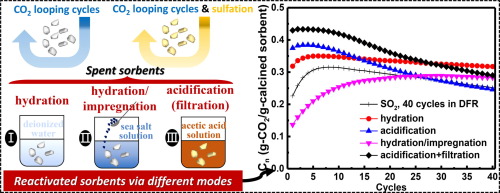Our official English website, www.x-mol.net, welcomes your
feedback! (Note: you will need to create a separate account there.)
Reactivation mode investigation of spent CaO-based sorbent subjected to CO2 looping cycles or sulfation
Fuel ( IF 6.7 ) Pub Date : 2020-04-01 , DOI: 10.1016/j.fuel.2020.117056 Jian Sun , Wenyu Wang , Yuandong Yang , Shan Cheng , Yafei Guo , Chuanwen Zhao , Wenqiang Liu , Ping Lu
Fuel ( IF 6.7 ) Pub Date : 2020-04-01 , DOI: 10.1016/j.fuel.2020.117056 Jian Sun , Wenyu Wang , Yuandong Yang , Shan Cheng , Yafei Guo , Chuanwen Zhao , Wenqiang Liu , Ping Lu

|
Abstract Rapid loss-in-capacity of naturally occurring limestone for CO2 capture is the most prominent issue in the calcium looping process. The synthesis of highly efficient sintering-resisting sorbents is a common solution to mitigate capacity decay. However, the long-term CO2 looping cycles, particularly in the presence of SO2, still cause the generation of large amounts of spent CaO-based sorbents. Comparatively, the reactivation of spent sorbent is more economical than the replenishing of fresh sorbent. In this work, three types of reactivation modes (i.e., hydration, simultaneous hydration/ impregnation and acidification) were applied to recover the CO2 capture capacities of the spent, synthetic CaO-based sorbents (CaO/MgO = 75 wt%/25 wt%). It is found that hydration is effective to recover the cyclic CO2 capture performance of the spent sorbent due to the formation of more cracks and channels that extend to the interior of sorbent particles. Therefore, the sorbent reactivated via sole hydration exhibits a high capacity of 0.390 g/g after 40 cycles. Moreover, NaCl impregnation combined with hydration produce lager amounts of macropores within the reactivated sorbents after initial sever sintering that are responsible for their desirable CO2 capture stability. The introduction of filtration during acidification reactivation process can effectively enhance the initial CO2 capture capacity (an improvement percentage of ~14.7%) owing to the removal of the irreversible CaSO4.
中文翻译:

经过 CO2 循环或硫酸化的废 CaO 基吸附剂的再活化模式研究
摘要 天然石灰石捕获 CO2 能力的快速损失是钙循环过程中最突出的问题。高效抗烧结吸附剂的合成是减轻容量衰减的常见解决方案。然而,长期的 CO2 循环循环,特别是在 SO2 存在的情况下,仍然会导致大量废 CaO 基吸附剂的产生。相比之下,废吸附剂的再活化比补充新鲜吸附剂更经济。在这项工作中,采用三种类型的再活化模式(即水合、同时水合/浸渍和酸化)来恢复废的合成 CaO 基吸附剂(CaO/MgO = 75 wt%/25 wt%)的 CO2 捕获能力)。发现由于形成更多延伸至吸附剂颗粒内部的裂缝和通道,水合可有效恢复用过的吸附剂的循环 CO2 捕获性能。因此,通过单独水合重新活化的吸附剂在 40 次循环后表现出 0.390 g/g 的高容量。此外,在初始切断烧结后,NaCl 浸渍与水合作用会在再活化的吸附剂中产生大量大孔,这些大孔是其理想的 CO2 捕获稳定性的原因。由于去除了不可逆的 CaSO4,在酸化再活化过程中引入过滤可以有效提高初始 CO2 捕获能力(提高百分比约 14.7%)。通过单独水合重新活化的吸附剂在 40 次循环后表现出 0.390 g/g 的高容量。此外,在初始切断烧结后,NaCl 浸渍与水合作用会在再活化的吸附剂中产生大量大孔,这些大孔是其理想的 CO2 捕获稳定性的原因。由于去除了不可逆的 CaSO4,在酸化再活化过程中引入过滤可以有效提高初始 CO2 捕获能力(提高百分比约 14.7%)。通过单独水合重新活化的吸附剂在 40 次循环后表现出 0.390 g/g 的高容量。此外,在初始切断烧结后,NaCl 浸渍与水合作用会在再活化的吸附剂中产生大量大孔,这些大孔是其理想的 CO2 捕获稳定性的原因。由于去除了不可逆的 CaSO4,在酸化再活化过程中引入过滤可以有效提高初始 CO2 捕获能力(提高百分比约 14.7%)。
更新日期:2020-04-01
中文翻译:

经过 CO2 循环或硫酸化的废 CaO 基吸附剂的再活化模式研究
摘要 天然石灰石捕获 CO2 能力的快速损失是钙循环过程中最突出的问题。高效抗烧结吸附剂的合成是减轻容量衰减的常见解决方案。然而,长期的 CO2 循环循环,特别是在 SO2 存在的情况下,仍然会导致大量废 CaO 基吸附剂的产生。相比之下,废吸附剂的再活化比补充新鲜吸附剂更经济。在这项工作中,采用三种类型的再活化模式(即水合、同时水合/浸渍和酸化)来恢复废的合成 CaO 基吸附剂(CaO/MgO = 75 wt%/25 wt%)的 CO2 捕获能力)。发现由于形成更多延伸至吸附剂颗粒内部的裂缝和通道,水合可有效恢复用过的吸附剂的循环 CO2 捕获性能。因此,通过单独水合重新活化的吸附剂在 40 次循环后表现出 0.390 g/g 的高容量。此外,在初始切断烧结后,NaCl 浸渍与水合作用会在再活化的吸附剂中产生大量大孔,这些大孔是其理想的 CO2 捕获稳定性的原因。由于去除了不可逆的 CaSO4,在酸化再活化过程中引入过滤可以有效提高初始 CO2 捕获能力(提高百分比约 14.7%)。通过单独水合重新活化的吸附剂在 40 次循环后表现出 0.390 g/g 的高容量。此外,在初始切断烧结后,NaCl 浸渍与水合作用会在再活化的吸附剂中产生大量大孔,这些大孔是其理想的 CO2 捕获稳定性的原因。由于去除了不可逆的 CaSO4,在酸化再活化过程中引入过滤可以有效提高初始 CO2 捕获能力(提高百分比约 14.7%)。通过单独水合重新活化的吸附剂在 40 次循环后表现出 0.390 g/g 的高容量。此外,在初始切断烧结后,NaCl 浸渍与水合作用会在再活化的吸附剂中产生大量大孔,这些大孔是其理想的 CO2 捕获稳定性的原因。由于去除了不可逆的 CaSO4,在酸化再活化过程中引入过滤可以有效提高初始 CO2 捕获能力(提高百分比约 14.7%)。











































 京公网安备 11010802027423号
京公网安备 11010802027423号